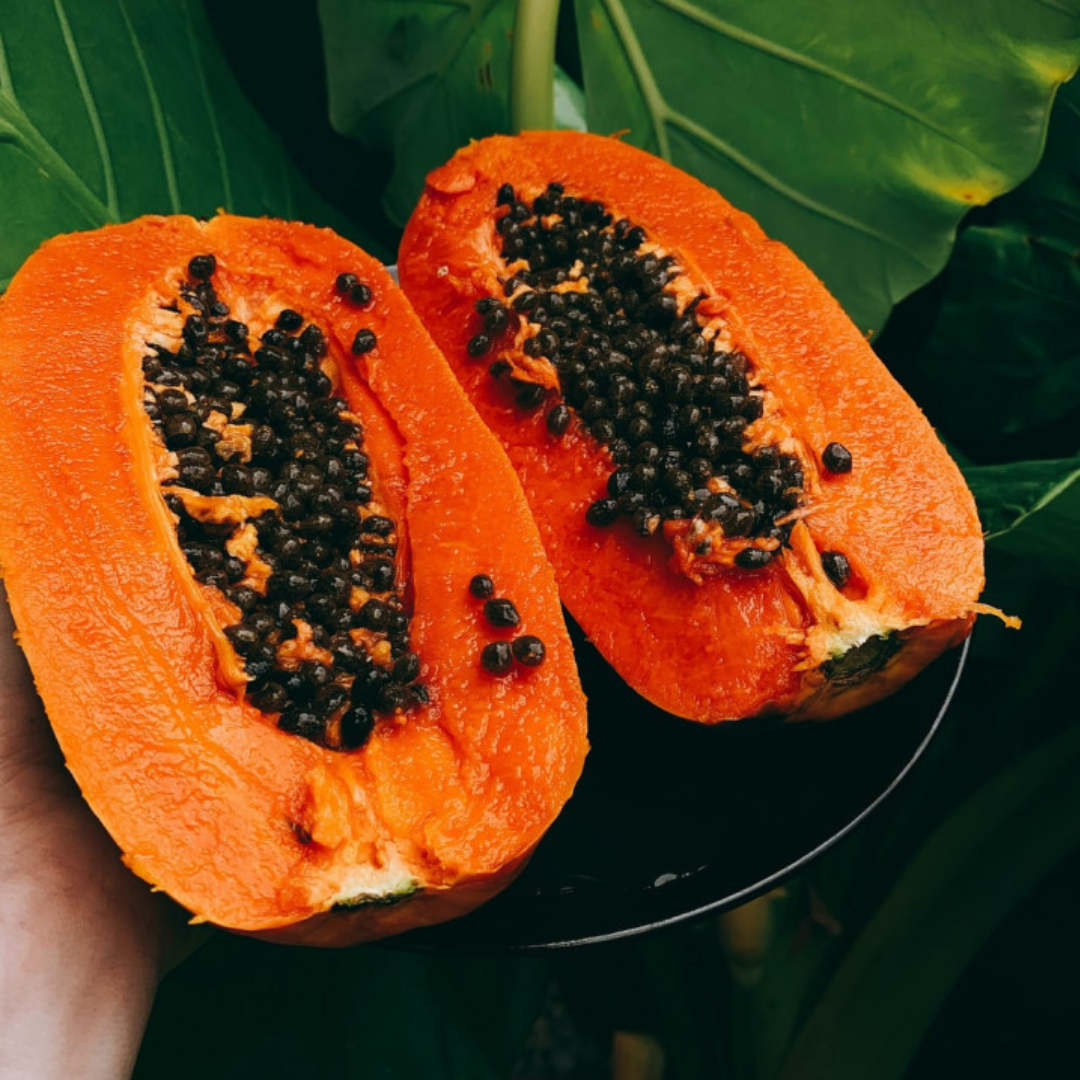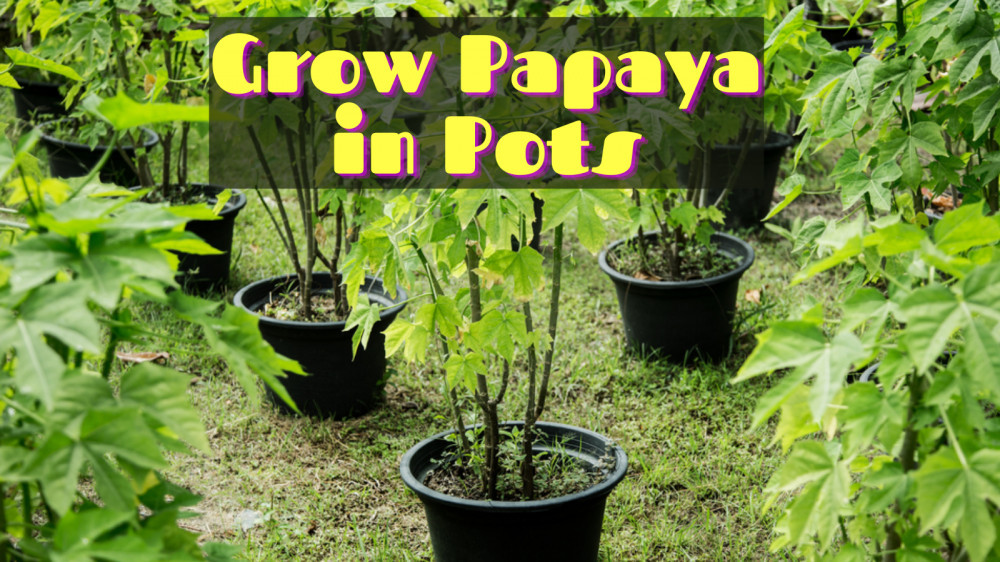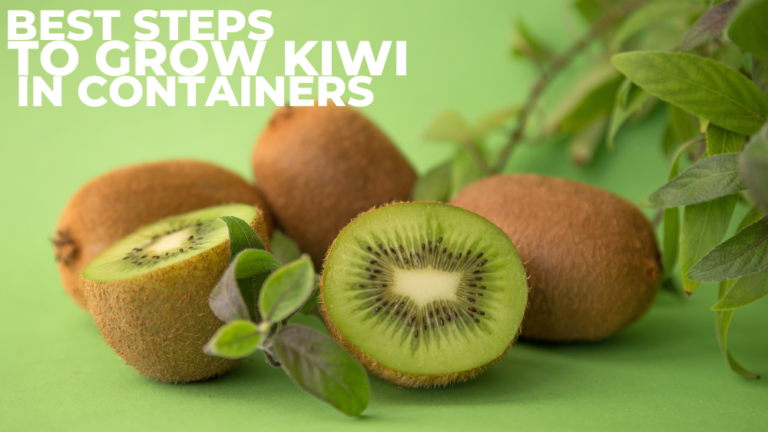Easy Steps To Grow Papaya In Pots
Easy Steps To Grow Papaya In Pots
Papaya is a herbaceous plant that overgrows and has a short lifespan. Cultivating mature papaya trees for more than three years is not commercially profitable because the fruit yield drops beyond that.
The tree has a hollow, segmented, erect stem with no branches. It has several huge, lobed leaves that are quite beautiful.
The plant may grow to a height of many meters (often 6-20 feet) and has a shallow root structure, making it a good choice for container cultivation.
The fruit comes in various shapes and sizes, depending on the cultivar and flower type.

Nutrition Facts About Papaya
The USDA provides the following nutrition information for 1 cup (145g) of raw papaya sliced into one-inch cubes.
- Calories: 62
- Fat: 0.4g
- Sodium: 11.6mg
- Carbohydrates: 16g
- Fibre: 2.5g
- Sugars: 11g
- Protein: 0.7g
- Vitamin A: 68.2mcg
- Vitamin C: 88.3mg

Health Benefits Of Papaya
1. Prevents Asthma
People who consume a lot of particular nutrients have a lower risk of having asthma. One of these nutrients is beta-carotene, which may be found in fruits and vegetables such as papaya, apricots, broccoli, cantaloupe, pumpkin, and carrots.
2. Improves Eye Health
Papayas are high in Vitamin A and antioxidants, aiding eye health. Vitamin A preserves the corneas, while antioxidants prevent retinal degeneration.
The delightful fruit offers all-around vision protection and even improves it. A balanced papaya diet can maintain your vision perfectly and prevent it from degrading.
3. Improves Bone Health
Low vitamin K intake has been linked to an increased risk of bone fracture. Adequate vitamin K consumption is essential for overall health because it enhances calcium absorption and may minimize urinary excretion, resulting in more calcium in the body to strengthen and rebuild bones.
4. Keeps Safe From Heart Disease
Papaya's fiber, potassium, and vitamin levels all aid in preventing heart disease. The essential dietary modification a person can do to lower their risk of cardiovascular disease is to increase potassium intake while decreasing sodium intake.
5. Controls Blood Sugar
People with type 1 diabetes who consume high-fibre diets have reduced blood glucose levels, while people with type 2 diabetes may have improved blood sugar, cholesterol, and insulin levels, according to research.
A small papaya contains approximately 3 grams of fiber, comparable to only 17 grams of carbohydrates.
6. Maintains Heart Disease
Papaya's fiber, potassium, and vitamin levels all aid in preventing heart disease. The essential dietary modification a person can do to lower their risk of cardiovascular disease is to increase potassium intake while decreasing sodium intake.
7. Helps To Lose Weight
Papaya is low in calories and high in fiber, which helps you feel fuller for longer. Papayas aid in overall weight loss by supporting a healthy digestive tract and immune system.
The natural fibres detoxify and cleanse the body, keeping it healthy and fit. Aside from that, the seeds found within the fruit hinder your body from absorbing fats; therefore, a handful of papaya seeds can also help you lose weight.
8. Improves Hair Growth
Papaya also benefits hair since it includes vitamin A, essential for sebum production and nourishes hair.
Vitamin A is also required to develop all bodily tissues, including the skin and hair.
Adequate vitamin C intake, which papaya may offer, is required to form and maintain collagen, which provides structure to the skin.
Different Types Of Papayas
There are numerous papaya kinds, and this tropical fruit has exceptionally high nutritional content! Here are some varieties ideal for growing papaya in pots.

1. Mexican Red Papaya
This type has a considerable size and a pleasant, rose-coloured pulp. The yellow ones contain yellow flesh and are significantly sweeter. They are available all year and range in size from 6 to 12 inches.

2. Hortus Gold Papaya
Hortus gold papaya is grown in South Africa. It has gorgeous bright yellow skin and produces hefty fruits, weighing 3-4 pounds and filling with yellow meat.

3. Hawaiian Sunrise Papaya
Its red-orange flesh, sometimes known as Strawberry papaya, is comparable to berries, peaches, and melons.
The cavity for the seeds is relatively shallow, making seed removal simple. This cultivar is available throughout the year.

4. Kamiya Papaya
The University of Hawaii pioneered the development of Kamiya papaya. The flesh is sweet and yellow-orange in hue, with a delicate aroma, smooth texture, and high sugar content.

5. Hawaiian Sunset Papaya
Sunset papaya is a dwarf variety developed at the University of Hawaii. It has meat and skin that are orange-red.
The fruit is smaller than the morning papaya. It has a more consistent colour and shape and a longer shelf life.
6. Oak Leaved Papaya
The oak-leafed papaya grows in the Andes Mountains of Western South America, producing little oval-shaped fruits 3-4 inches long. This papaya's seeds, as well as its orange-coloured juicy, pulpy flesh, are edible.

7. Kapoho Papaya
The flesh of this papaya type is sweet and golden. It is popular in Hawaii's Puna district, where about 90% of the state's papayas are grown.

8. Samba Papaya
This newest type was released on the market in 2018. It has an oval form and yellow-green speckled skin. The pulp is dark orange and tastes slightly sweet.

9. Bettina Papaya
Bettina is primarily grown in Queensland, Australia. This easy-to-grow papaya produces spherical fruits weighing around 3-5 pounds per. It has pleasant flesh and only a few seeds.
10. Peterson Papaya
Peterson was born in Queensland, Australia. It has yellow skin with green spots as well. The dark orange flesh has a sweet, enticing flavour.

11. Royal Star Papaya
Another new member of the papaya family is Royal Star. It is a cross between Mexican red and Texas red. The papaya has deep orange skin and delicious, juicy pulp.

12. Guinea Gold Papaya
The Guinea gold papaya is indigenous to Western Australia. It produces pearls with a thin golden yellow peel and flesh. The fruit can weigh more than 2-3 pounds and ripens over 15-18 months.

13. Waimanalo Papaya
Waimanalo papaya is farmed entirely on the island of Oahu in Hawaii. It's a dwarf cultivar with many Vitamin C. This plant overgrows and bears fruit in 9-10 months.

14. Tainung Papaya
Formosa papaya is another name for this cultivar. A Sunrise papaya hybrid measures about 3-4 pounds when ripe. Tainung is a long, elongated fruit with delicious pink or light red flesh.
Easy Steps To Grow Papaya In Pots
Grow Papaya In Pots From Seeds
Seeds must be treated before sowing to germinate:
The first technique is to wash the seeds before sowing to remove the jelly covering, then proceed to step five below.
Another option is to soak them in a jar filled with tepid water for four days. Twice a day, change the water.
Separate the seeds floating on the surface from those that have sunk after 2 days of soaking.
Keep the seeds that have settled for another day. The seeds that float up again after this time must be removed.
Only viable papaya seeds will be left in this manner. Fungicides should be added to the water on the last day it is changed.
Afterward, wrap the seeds in a cotton cloth for 2 days to keep them wet. They are ready to sow after the white dot can be seen in them.
Sow the seeds directly on the ground or in a container. If you use seed pots, make sure they're biodegradable because papaya plants don't transplant well, and you'll have a low success rate if you don't.
In 1-3 weeks, the seeds will germinate. It can take up to 5 weeks in less-than-ideal conditions, so don't quit too soon! The ideal germination temperature is around 70 degrees Fahrenheit (20 C).

Choose The Perfect Location
Learning how to cultivate papaya entails selecting an appropriate area to grow it. Because papaya does not handle transplanting well, select a permanent location for the plant.
Because papaya has strong photosynthetic activity, it requires a warm, sunny location to flourish.
This plant does not appreciate being in the shadow. Shades are a detriment to papaya. A sunny location with plenty of sunlight is ideal for papaya.
You should also attempt to keep it away from strong winds, as its stem is quite delicate and easily broken.

Choose The Right Container
Plant papayas in large containers with a width of at least 18 to 24 inches. Use a large pot like this if you have one sitting around.
Papayas require as much space as possible. Planters are available in various materials, including ceramic, wood, plastic, and metal, and are all appropriate for growing papayas.
Before you begin planting, position your planter in its proper location. The planter will weigh 125 pounds when packed with soil and mature papaya.
Drainage is a must-have feature for your papaya planter. Use only containers with holes in the bottom to let the excess water drain; otherwise, water will collect and cause root rot problems.

Soil Requirements
When it comes to soil, papaya is picky. It necessitates the use of high-quality soil. The best papaya soil is well-draining, high in organic content, fertile and deep, and primarily loose and moist. It also prefers a neutral pH range of 6.0 to 7.0.
Choose loamy soil rich in organic matter that drains well and keeps moisture effectively to maximize development and yield. The dirt is very compacted.
Deep soil is also essential. The deeper the soil, the more effectively the seeds germinate. Before planting, make sure your soil is free of debris and pebbles.
Drainage is also necessary for the growth of papaya. You should choose sandy soil instead of clay soil. The latter causes root rot by slowing water movement.
It can also stifle plant growth and cause a variety of deficiencies, including zinc, iron, and other microelement shortages.
Sandy soil drains more efficiently. However, don't use soil that is too sandy because it is ineffective at retaining water.
Planting The Tree
Sow the seedlings immediately in the intended location once they germinate. If you bought your plants from a nursery, prepare the ground thoroughly before planting. Dig a hole twice as deep as the plant's rootball but twice as wide.
The slow release should be used. 16-48-0, 18-46-0, or balanced 15-15-15 fertilizer as directed on the package, but in a lower dose towards the bottom of the hole. Fill it with a thin layer of dirt later to keep the plant roots from directly touching the fertilizer.
The base of each plant should be 1 cm above ground level to prevent rot at the stem base. A fungicide can be used after transplanting to provide further protection, especially if planted on rainy days.
Temperature
Temperature plays a significant role in the growth of your papaya. Papaya grows and thrives well in temperatures around 68°F. If the temperature dips below 30°F, your plant may die. Frost is poisonous to papaya.
You should also keep in mind that low temperatures will surely hamper papaya growth and delay the germination rate of the seeds.
You should ensure you live in a region where the temperature does not exceed 90°F. Papaya is highly vulnerable to high temperatures and heat waves, which inhibit plant growth.

Watering
The plant is composed of 85 percent water. Water is essential for the growth of papaya. Water the plant regularly over the first several months to help it germinate and flourish. Don't, however, overwater. Maintain moist but not soggy soil.
Watering should be done every two or three days. Before watering, dip your finger into the soil to discover if it is dry and needs moisture.
Fertilizing
Younger plants should be fertilized more regularly with tiny doses of a complete, balanced fertilizer like 12-12-12.
Apply ¼ pound every 14 days, thoroughly wetting it in. The University of Hawaii Extension recommends applying micronutrients monthly and iron treatments every other month.
Fertilize the papayas every other month after they are seven to eight months old, using 1 to 2 pounds of 12-12-12 balanced fertilizer per plant, working it into the top layers of soil out past the drip line and then thoroughly watering the trees.
Reduce the amount of fertilizer used if growth slows during the cooler months of fall and winter.
Because papayas like dry soil in cool weather, fertilizer treatments may accumulate without enough watering or rain to move it into deeper soil layers.
Papaya For Cold Climate
Although papaya is a tropical fruit tree, if you want to grow it in a temperate zone, plant it in a large pot and try to overwinter it in a well-protected area, such as a greenhouse.
Another option is to start the seeds indoors in the fall or early spring. When the temperature rises enough to place the seedlings outside, the trees will grow until chilly weather arrives and kill them, but there's a chance you'll get some luscious papayas.
Even if you don't receive any fruits, these plants are attractive. If you don't have a greenhouse, keep it indoors in a warm place during the winter.
Cover the pot with bubble wrap to insulate and protect the roots. In the winter, reduce watering and fertilization.

Harvesting
Within 10 to 12 months of planting, you should be able to harvest papaya fruits. Because the fruits are particularly sensitive to sunlight and may burn, you should harvest them as soon as they are ready. Wear gloves when harvesting the fruits and cut them gently with a sharp knife.
You can tell which fruits are ripe by their colours. Fully ripe fruits should be yellow to orange in hue.
You should first collect them and keep them away from direct sunshine. Because papaya fruits continue to ripen even after being cut, you can collect green fruits and preserve them until they ripen.
Pests & Diseases Of Papaya
Knowing how to cultivate papaya isn't enough to ensure its survival; you'll also need to know how to protect it from pests and viruses.
A slew of parasites and diseases threatens this fragile fruit. Fruit flies, mites, black vine weevil, aphids, leafhoppers, and whiteflies are the most frequent pests that might attack your plants.
Soil fungus, powdery mildew, fruit rot, papaya ringspot virus, and nematodes should all be avoided.
As a result, you should regularly inspect your plants for pests and illnesses, and if you notice black spots on some of the leaves, you should remove the affected leaves right away.

Conclusion
These ten measures will ensure that you successfully grow papaya. Following the recommendations above, your plant will live for three years and produce many fruits. Enjoy the process of cultivating papaya, and share your feedback with us.
I trust you enjoyed this article on the Easy Steps To Grow Papaya In Pots. Please stay tuned for more blog posts to come shortly. Take care!
JeannetteZ
>>>Please click here to find 14 Healthy Vegan Papaya Smoothie Recipes on my LivingTheVeganLifestyle.org website<<<
>>>Please click here to read my all-inclusive article about Container Gardening<<<
>>>Are you interested in homegrown herbs and medicine? Please click here to find out more about it!<<<
Your Opinion Is Important To Me
Thoughts? Ideas? Questions? I would love to hear from you. Please leave me your questions, experience, and remarks about this article on the Easy Steps To Grow Papaya In Pots in the comments section below. You can also reach me by email at Jeannette@Close-To-Nature.org.
You might also enjoy these blog posts:
5 Easy Steps Of Growing Fuchsia Flowers In Pots
Best Ways To Get Nature Therapy
9 Top Relaxing Nature Places In The World








